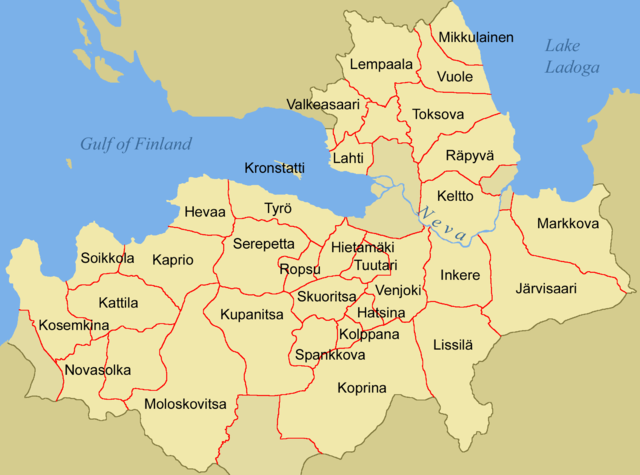Top Qs
Timeline
Chat
Perspective
Ingrian Finnish dialects
Group of dialects of Finnish From Wikipedia, the free encyclopedia
Remove ads
Ingrian Finnish dialects (Finnish: Inkerin suomalaismurteet) are the Finnish dialects spoken by Ingrian Finns around Ingria in Russia. Today, the Ingrian dialects are still spoken in Russia, Finland and Sweden.[2] In 2010 there were only 20 300 Ingrian Finns left in Russia.[3] The Ingrian dialects are gradually dying out, as primarily elderly people speak them still,[1] and unlike Standard Finnish, the dialects are not taught in schools.[4]
Remove ads
History
After Sweden annexed Ingria in 1617, many people moved to Ingria from Finland, at the time part of Sweden. After Russia annexed it again around 1700, many Russians moved in. However the Finnish language stayed because of the Lutheran church; the difference of religion made mixed marriages rare.
In 1900 the situation changed a lot. At first, minority languages were supported; however, around 1930 Finnish was banned and the Ingrian Finns were deported and genocided. Because of this, language communities broke and Russian influence became larger.[5]
Remove ads
Phonology
Summarize
Perspective
The phonology of Ingrian Finnish is very much alike that of the neighbouring Ingrian and Votic languages.
One process present in the dialects is the deletion of final front vowels and their replacement by palatisation, much like in Ala-Laukaa Ingrian and Votic:[4]
- äitj ([æi̯tʲ], "mother") for Standard Finnish äiti ([ˈæi̯ti])
- vesj ([ʋes̠ʲ], "water") for Standard Finnish vesi ([ˈʋes̠i])
- mäkj ([mækʲ], "hill") for Standard Finnish mäki ([ˈmæki])
- kylj ([kylʲ], "village") for Standard Finnish kylä ([ˈkylæ])
Another is the diphthongisation of historically long vowels in initial syllables, much like in the Karelian language:[4]
- piä ([piæ̯], "head") for Standard Finnish pää ([pæː])
- kualj ([kuɑ̯lʲ], "cabbage") for Standard Finnish kaali ([ˈkɑːli])
Like in the Ingrian language, Standard Finnish morphological -d- is often replaced by -v-, -vv- and -ij-:[4]
- sovan ([ˈs̠oʋɑn], "war", gen) for Standard Finnish sodan ([ˈs̠od̪ɑn]
- pöyvvän ([ˈpøy̯ʋːæn], "table", gen) for Standard Finnish pöydän ([pøy̯d̪æn])
Finally, a shift of the diphthongs [ie̯], [uo̯] and [yø̯] to [iɑ̯] ([iæ̯] in front-vocalic stems), [uɑ̯] and [yæ̯] respectively is present:[6]
- piänj ([piæ̯nʲ], "small") for the Standard Finnish pieni ([pie̯ni]).
Remove ads
Grammar
The dialects' personal pronouns differ significantly from the standard language. Follows a comparison with the Karelian language and Standard Finnish:
Vocabulary
Historically, multiple Swedish loanwords have appeared in Ingrian Finnish. Furthermore, the dialects have borrowed extensively from the neighbouring Finnic languages. In more recent years, it has also borrowed extensively from the Russian language:[4]
- latjjat ([ˈlɑtʲjɑt̪], "dress") from Russian платье (plat'je)
- liäppä ([ˈliæ̯pːæ], "hat") from Russian шляпа (šljapa)
Sample text
Follows a sample text in Ingrian Finnish:[6]
Remove ads
See also
- Ingrian Finns
- Siberian Ingrian Finnish – Ingrian Finnish – Ingrian mixed language
- South Karelian dialects
- Savonian dialects
References
Wikiwand - on
Seamless Wikipedia browsing. On steroids.
Remove ads

